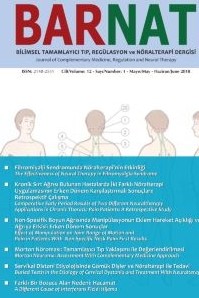EFFICACY OF NEURAL THERAPY IN THE TREATMENT OF NOTALGIA PARESTHETICA: REPORT OF TWO CASES
Notalgia paresthetica (NP) is a common sensory neuropathic syndrome with the symptoms of localized pruritus and dysesthesia of the
unilateral infra scapular region. NP is a rarely reported T2-T6 sensory neuropathy whose etiology and treatment are not fully established
and the clinical course consists of remissions and relapses.
We report two cases whom admitted to our clinic with a back burning sensation and we detected a hyperpigmented pruritic skin lesion
in the scapular region. On inspection, hyperpigmented macular cutaneous lesions were seen on the scapular region. Neurological examination
and biochemical blood tests were normal. Degenerative changes were observed on cervical and thoracic plain radiographs.
The presence of hyperpigmented macular lesions on the scapular area of the patient and analgesic-resistant dorsal pain led us to the
diagnosis of NP. We applied to these patients T2-T10 local segmental and to the hyperpigmented area with 1% lidocaine for treatment.
After 2 week, the pain which was detected by a visual analog scale (VAS) declined. We applied the Leeds assessment of neuropathic
symptoms and signs (LANSS) Pain Scale to analyse of of sensory dysfunction.
The aim of study is to determine the efficacy of treatment of notalgia paresthetica using neural therapy , assessing the degree of improvement
in itching and burning sensation. Moreover, to evaluate the signs and symptoms associated with notalgia paresthetica. As a result,
NP is a disorder that should be kept in mind in the presence of neuropathic upper back pain and hyperpigmented skin lesions. Neural
therapy may be an alternative option that can be successfully applied in the treatment of these patients.
EFFICACY OF NEURAL THERAPY IN THE TREATMENT OF NOTALGIA PARESTHETICA: REPORT OF TWO CASES
Notalgia paresthetica (NP) is a common sensory neuropathic syndrome with the symptoms of localized pruritus and dysesthesia of the
unilateral infra scapular region. NP is a rarely reported T2-T6 sensory neuropathy whose etiology and treatment are not fully established
and the clinical course consists of remissions and relapses.
We report two cases whom admitted to our clinic with a back burning sensation and we detected a hyperpigmented pruritic skin lesion
in the scapular region. On inspection, hyperpigmented macular cutaneous lesions were seen on the scapular region. Neurological examination
and biochemical blood tests were normal. Degenerative changes were observed on cervical and thoracic plain radiographs.
The presence of hyperpigmented macular lesions on the scapular area of the patient and analgesic-resistant dorsal pain led us to the
diagnosis of NP. We applied to these patients T2-T10 local segmental and to the hyperpigmented area with 1% lidocaine for treatment.
After 2 week, the pain which was detected by a visual analog scale (VAS) declined. We applied the Leeds assessment of neuropathic
symptoms and signs (LANSS) Pain Scale to analyse of of sensory dysfunction.
The aim of study is to determine the efficacy of treatment of notalgia paresthetica using neural therapy , assessing the degree of improvement
in itching and burning sensation. Moreover, to evaluate the signs and symptoms associated with notalgia paresthetica. As a result,
NP is a disorder that should be kept in mind in the presence of neuropathic upper back pain and hyperpigmented skin lesions. Neural
therapy may be an alternative option that can be successfully applied in the treatment of these patients
___
- Shumway NK, Cole E, Fernandez KH. Neurocutaneous disease: neurocutaneous dysesthesias. J Am Acad Dermatol 2016; 74: 215-228.
Ellis C. Notalgia paresthetica: the unreachable itch. Dermatol Pract Concept. 2013;3:3-6.
